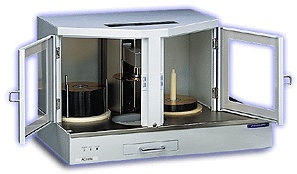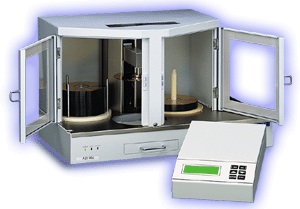If you are in the market for a medium-duty, autoloading CD duplicator, Chugai Boyeki’s AD1050 is well worth considering. It operates effectively and reliably and offers a full range of functions in both PC and standalone configurations.
Chugai Boyeki Discmatic AD1050
Hugh Bennett
EMedia Professional, September 1998
 The Discmatic AD1050 may sound like GE’s latest kitchen marvel — a name better-suited to a dishwasher than a disc-duper. But the Discmatic is actually a solid CD duplication system from industry newcomer Chugai Boyeki, an established Japanese trading and manufacturing company with experience in optical and electronic markets.
The Discmatic AD1050 may sound like GE’s latest kitchen marvel — a name better-suited to a dishwasher than a disc-duper. But the Discmatic is actually a solid CD duplication system from industry newcomer Chugai Boyeki, an established Japanese trading and manufacturing company with experience in optical and electronic markets.
Available in both PC-based and standalone configurations, the Discmatic AD1050 integrates proven components in a flexible modular fashion to offer unattended 50-disc creation or duplication at 4X recording speed.
I, ROBOT
At the heart of the Discmatic AD1050 system is Nistec Corporation’s ALW-501 CD Autorecorder disc-handling robot. A 50-disc pick-and-place autoloader, the ALW-501 has been available to the market for several years and proven itself ably suited for low- and medium-level duplication duties. The system’s form and function are elegantly simple; while neither flashy nor particularly fast, the ALW-501 gets the job done competently and reliably.
A compact case houses the transport robot plus a single TEAC CD-R55S 4X write/12X read recorder. The disc input stack and output spindle are easily accessible through swinging metal doors, and clear plastic windows allow users to view all the action. A small sliding drawer is accessible from the front of the unit and holds up to seven rejected discs.
The ALW-501 employs a single robotic arm that resides in a vertical tower in the center of the machine and is flanked by the disc input stack to its left and the output spindle to its right. A pocket below the operational area houses the recorder, whose tray opens to the position directly underneath the central tower and robot arm. The tower pivots from side to center to side as required to move the robotic arm to the correct horizontal position. The arm then moves vertically to the correct height either to grasp or release a disc.
With system complexity kept to the bare minimum of electric stepper motors, gears, pulleys, and cables, the ALW-501’s mechanical reliability is predictably excellent. During testing, the robot completed 1,000 input/output cycles successfully and without incident. Users should feel confident that when they leave the system to duplicate a project overnight they will return to a stack of finished discs in the morning rather than a jammed mechanism and an error light.
For all of its charms, the ALW-501 does have a few failings. For example, the reject bin seems little more than an ashtray and lacks a sensor to detect how many discs are present. The unit also offers no external SCSI ID selector for the built-in CD recorder, which makes connecting it to a computer more awkward than need be.
TO PC CONNECT, USE CD REP
The basic $4,780 AD1050 package connects to the serial port of a suitable Pentium PC and is operated using a special version of Prassi Software’s CD Rep for Windows 95 and NT 4.0. CD Rep functions using a standard job card model allowing up to 16 sequential recording jobs to be set up and run at one time. Disc duplication functions are offered as well as rudimentary ISO 9660 premastering capability, with recording taking place in both Disc-At-Once and Track-At-Once modes.
Four types of job cards can be mixed and matched including on-the-fly disc copying, image file recording, and ISO 9660 and audio/mixed mode premastering and recording. Pure disc duplication is straightforward and simply involves creating and naming a new job card, selecting the source device containing the master disc, and specifying the recording speed and the number of copies to be made. An intermediate image can also be created, and the verification-after-writing function can be enabled as well. During writing, the progress of the jobs can be monitored through a panel which provides project status and graphically displays progress along a time line.
CD Rep performs well and is flexible and reasonably easy to use, but lacks some important time-saving features. For example, all duplication jobs must be set up ahead of time rather than permitting the autoloader to read multiple master discs from the input stack and performing a batch copy.
 STANDALONE: EASILY DONE WITH EZ-ONE
STANDALONE: EASILY DONE WITH EZ-ONE
For users who require greater operational simplicity than CD Rep offers, and for those who can’t conveniently dedicate a computer for the long periods of time multiple disc duplication demands, Chugai also offers a standalone version of the AD1050 for $6,480.
The Discmatic AD1050 becomes a standalone duplication unit when purchased with the EZ-ONE control unit, a separate compact box containing a 4GB hard drive, control electronics, a 20 X 4 character backlit LCD display, and six-button (yes/no/up/down/enter/stop) membrane keypad. A separate power brick is used to keep the package’s size to a minimum. Hooking up the EZ-ONE to the autoloader is straightforward and involves connecting a single SCSI and one RS-232 serial cable between the two boxes.
At the heart of the EZ-ONE is R-Quest’s CopyQuest CD controller, one of the number of off-the-shelf standalone controllers now available to the CD duplication industry and also used by a number of competing manufacturers including Champion Duplicators and Cedar Technologies.
The EZ-ONE offers all standard writing modes including Disc-At-Once, Track-At-Once, and multisession. EZ-ONE also supports most popular disc formats but with several notable exceptions, among them Rock Ridge, CD-i, CD+G/M, and 3DO. While these omissions won’t pose a problem for most AD1050 users, service bureaus, replicators, and mastering houses should take note since almost any type of disc duplication job can come through their door.
The AD1050 does offer a broad range of easy-to-use functions and can accomplish disc copying in several ways. The most straightforward and flexible duplicating method is batch mode, which involves placing the number of blank CD-R discs to be written in the autoloader’s input stack with the master to be duplicated on the top of the pile. When the user initiates the copying process, the system reads the master disc into the internal hard drive and writes to the blank discs in the input stack. Like many controllers in its class, the EZ-ONE also allows operators to spread multiple masters among the blank discs in the input stack so multiple jobs can be set up ahead of time and the system can be left to work unattended.
In contrast to batch mode, the manual copying option enables the user to save multiple master disc images on the internal hard drive for immediate or future copying. Individual names can be given to each image for easy management so that copying simply requires selecting the appropriate image file and entering the number of copies to be recorded. An optional comparison option ensures accuracy by allowing masters and copies to be compared to hard drive-stored image files.
FLEX-APPEAL
In exchange for the awkwardness of having a separate standalone controller and robotic autoloader, purchasers can gain a degree of modular flexibility with their Discmatic purchase. For example, the less expensive PC-based AD1050 can be upgraded later to a standalone system by purchasing and adding just the EZ-ONE controller. And if the need ever arises to run the AD1050 from the PC again, it is a simple matter to disconnect the controller.
Bear in mind that Chugai Boyeki also offers the MD3000 three-recorder and MD7000 seven-recorder duplication towers, which can be operated using the EZ-ONE controller. This common architectural element means that users with both AD1050 and MD3000/7000 systems need to purchase the standalone controller only once and move it between each duplicator as required.
If you are in the market for a medium-duty, autoloading CD duplicator, Chugai Boyeki’s AD1050 is well worth considering. It operates effectively and reliably and offers a full range of functions in both PC and standalone configurations. However, Chugai is certainly not the only company offering solutions using similar components, so competing systems like MediaFORM’s CD-2701 and Mitsui Advanced Media’s Trans/Corder also deserve a serious look.
Product in Brief
Synopsis: The Discmatic AD1050 is a solid CD duplication system from industry newcomer Chugai Boyeki, an established Japanese trading and manufacturing company with experience in optical and electronic markets. Available in both PC-based and standalone configurations, the Discmatic AD1050 integrates proven components in a flexible modular fashion to offer unattended 50-disc creation or duplication at 4X recording speed.
Prices: AD1050 with EZ-ONE standalone controller, $6,480; AD1050 with CD Rep software, $4,780; EZ-ONE standalone controller, $2,130
For more information, contact:
Chugai Boyeki (America) Corporation
55 Mall Drive
Commack, NY 11725
800/422-6707
516/864-9700
Fax 516/864-9710
http://www.chugai.com
http://www.discmatic.com
About the Author
Hugh Bennett, editor-in-chief of Hugh’s News, is president of Forget Me Not Information Systems, a reseller, systems integrator and industry consultant based in London, Ontario, Canada. Hugh is author of The Authoritative Blu-ray Disc (BD) FAQ and The Authoritative HD DVD FAQ, available on Hugh’s News, as well as Understanding Recordable & Rewritable DVD and Understanding CD-R & CD-RW, published by the Optical Storage Technology Association (OSTA).
Copyright © Online Inc. / Hugh Bennett